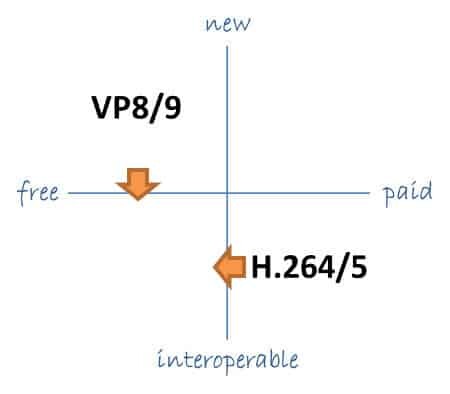Back to square one. Who’s to gain from this?
The IETF meeting came and went. Cisco pulled up a rabbit in the form of openH264, and the result was more delay. We’re now all back to square one, with no decision to be made.
On the table are two options: VP8 and H.264.
Same as last year.
What’s at stake? Royalty free versus the size of the ecosystem.
We’re still looking at the same diagram, with little change to it:

H.264 now has the emperor’s new clothes that indicate it is “free”, courtesy of Cisco. That freedom, as all magic as we all know, comes with a price dearie.

The price for this freedom?
- Continuing on the H.265 track, which will definitely be royalty bearing
- Dealing with the hassles of getting such an “accommodation” to work for iOS apps and server side deployments
- Keeping MPEG-LA alive and kicking. And dominant
Then there’s VP8. With Nexus 5 reportedly supporting it, which places Qualcomm as a dominant chipset with VP8 support. But not much more. And the install base is still dismally small if you start talking of all the stupid legacy set-top boxes people have at homes (those that don’t even have the ability to connect to a camera, mind you).
Indecision in this case isn’t good for the H.264 camp. The way I see it, it will lose the hegemony of whining about interoperability and using the excuse of ecosystem supporting VP8 – chipsets and other vendors that breathe life into a codec. The more time that passes, the more people get acquainted to VP8 and the more products that roll out supporting it.
The more time that passes, the less H.264 or VP8 will be interesting and the more H.265 and VP9 will become more relevant.
No decision is deciding that the de facto solution out there is going to win the day. And that’s whatever Chrome has to offer in the browser. Which is VP8.
- Google didn’t lose, but the stretch of time means more adoption
- Cisco won a front seat at the WebRTC decision making table
- Microsoft won more time to prepare Skype for a brave new world
- Apple? Who knows
- Who is the main loser? The consumers and vendors who want to focus on use cases and need to deal with the hassles of indecision.
It reminds me why I hate standardization processes so much.
–
Next week, I will be attending the WebRTC Conference and Expo in Santa Clara. If you are around there – come say hello.


If I listened correctly to the IETT RTCWeb WG meeting recording I think it is possible no MTI Video codec will be on the table as well.
I also see SHOULD or RECOMMENDED to implement instead of MUST on the mailinglist.
And also Theora and MPEG-1/H.261 were mentioned. It would be good to have even a lowquality fallback MTI video codec if there is no other MTI.
I can’t imagine G.711 was choosen because of it’s quality either 😉
Tsahi San,
I think that most of the people will appreciate your observation of the impact of the codec trend. I do hope that some one can finalize the codec issues so that two Quanta’s HW VP8 and H.264 encoder can sells more!
please meet my colleagues who will attend the WebRTC- Tim Shieh who has been the WebRTC advocate in Quanta Computer since day one and Sagin Hsu who is your old friend.
God bless us all!
Jammy
Jammy,
Would love to meet Sagin again – missed you guys 🙂
Tsahi